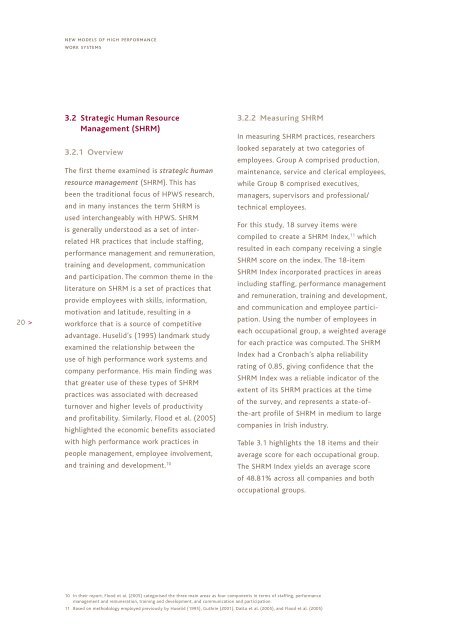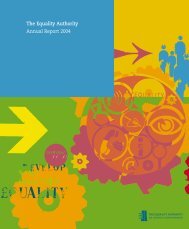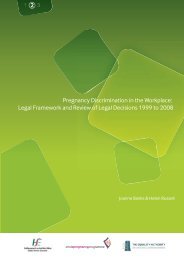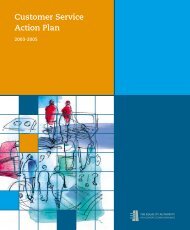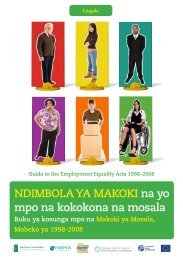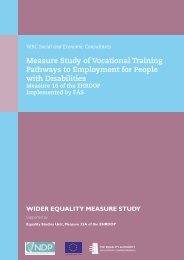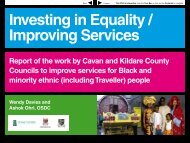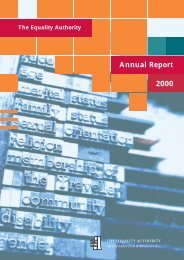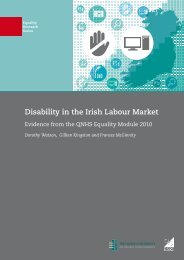New Models of High Performance Work Systems - Equality Authority
New Models of High Performance Work Systems - Equality Authority
New Models of High Performance Work Systems - Equality Authority
- No tags were found...
You also want an ePaper? Increase the reach of your titles
YUMPU automatically turns print PDFs into web optimized ePapers that Google loves.
new models <strong>of</strong> high performancework systems20 >3.2 Strategic Human ResourceManagement (SHRM)3.2.1 OverviewThe first theme examined is strategic humanresource management (SHRM). This hasbeen the traditional focus <strong>of</strong> HPWS research,and in many instances the term SHRM isused interchangeably with HPWS. SHRMis generally understood as a set <strong>of</strong> interrelatedHR practices that include staffing,performance management and remuneration,training and development, communicationand participation. The common theme in theliterature on SHRM is a set <strong>of</strong> practices thatprovide employees with skills, information,motivation and latitude, resulting in aworkforce that is a source <strong>of</strong> competitiveadvantage. Huselid’s (1995) landmark studyexamined the relationship between theuse <strong>of</strong> high performance work systems andcompany performance. His main finding wasthat greater use <strong>of</strong> these types <strong>of</strong> SHRMpractices was associated with decreasedturnover and higher levels <strong>of</strong> productivityand pr<strong>of</strong>itability. Similarly, Flood et al. (2005)highlighted the economic benefits associatedwith high performance work practices inpeople management, employee involvement,and training and development. 103.2.2 Measuring SHRMIn measuring SHRM practices, researcherslooked separately at two categories <strong>of</strong>employees. Group A comprised production,maintenance, service and clerical employees,while Group B comprised executives,managers, supervisors and pr<strong>of</strong>essional/technical employees.For this study, 18 survey items werecompiled to create a SHRM Index, 11 whichresulted in each company receiving a singleSHRM score on the index. The 18-itemSHRM Index incorporated practices in areasincluding staffing, performance managementand remuneration, training and development,and communication and employee participation.Using the number <strong>of</strong> employees ineach occupational group, a weighted averagefor each practice was computed. The SHRMIndex had a Cronbach’s alpha reliabilityrating <strong>of</strong> 0.85, giving confidence that theSHRM Index was a reliable indicator <strong>of</strong> theextent <strong>of</strong> its SHRM practices at the time<strong>of</strong> the survey, and represents a state-<strong>of</strong>the-artpr<strong>of</strong>ile <strong>of</strong> SHRM in medium to largecompanies in Irish industry.Table 3.1 highlights the 18 items and theiraverage score for each occupational group.The SHRM Index yields an average score<strong>of</strong> 48.81% across all companies and bothoccupational groups.10 In their report, Flood et al. (2005) categorised the three main areas as four components in terms <strong>of</strong> staffing, performancemanagement and remuneration, training and development, and communication and participation.11 Based on methodology employed previously by Huselid (1995), Guthrie (2001), Datta et al. (2005), and Flood et al. (2005)


